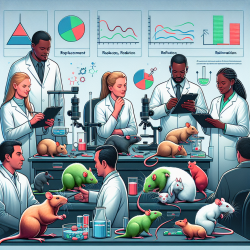Introduction
In the realm of pediatric speech therapy, understanding the underlying causes of neurological conditions can significantly enhance therapeutic outcomes. Recent research titled "Characterization of spastic paraplegia in a family with a novel PSEN1 mutation" provides groundbreaking insights into the genetic factors influencing spastic paraplegia and its implications for speech therapy. This blog explores how practitioners can leverage these findings to refine their therapeutic approaches and improve outcomes for children.
The Study: A Brief Overview
The research conducted by Ringman et al. (2023) focuses on a family with a novel PSEN1 mutation, which led to early-onset spastic paraplegia. The study highlights the mutation's impact on amyloid-beta peptide production, contributing to neurological symptoms. This mutation was associated with severe amyloid pathology and white matter abnormalities, which are critical considerations for speech therapists working with affected children.
Implications for Speech Therapy
Understanding the genetic basis of neurological conditions can significantly influence speech therapy strategies. Here are some key takeaways for practitioners:
- Early Identification: Genetic insights can aid in the early identification of children at risk for spastic paraplegia, allowing for timely intervention.
- Customized Therapy Plans: Knowledge of specific genetic mutations can help tailor therapy plans to address the unique needs of each child, focusing on areas most likely to be affected by the mutation.
- Interdisciplinary Collaboration: Collaboration with geneticists and neurologists can provide a comprehensive understanding of the child's condition, enhancing the effectiveness of speech therapy.
- Monitoring Progress: Genetic markers can serve as indicators for monitoring the progression of the condition and adjusting therapy plans accordingly.
Encouraging Further Research
While the study offers valuable insights, it also underscores the need for further research. Practitioners are encouraged to engage in collaborative research efforts to explore the broader implications of genetic mutations on speech and language development. By contributing to this growing body of knowledge, speech therapists can play a pivotal role in advancing therapeutic approaches and improving outcomes for children with genetic conditions.
Conclusion
The intersection of genetic research and speech therapy holds immense potential for transforming pediatric care. By integrating genetic insights into therapeutic practices, practitioners can enhance their ability to deliver personalized, effective interventions. As we continue to unravel the complexities of genetic influences on neurological conditions, the future of pediatric speech therapy looks promising.
To read the original research paper, please follow this link: Characterization of spastic paraplegia in a family with a novel PSEN1 mutation.










